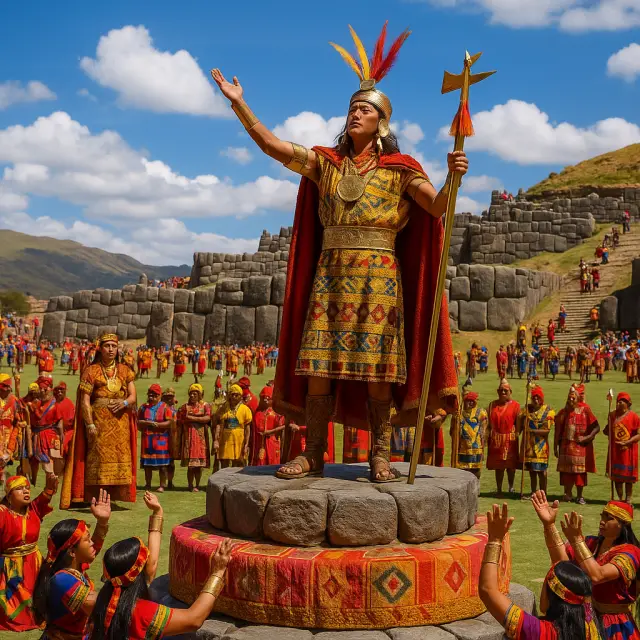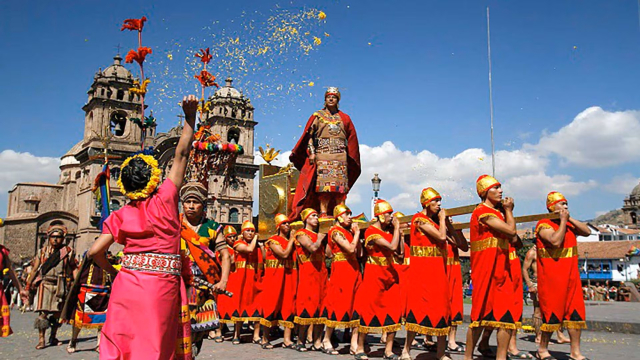Inti Raymi was officially established by the Inca Pachacútec in the 15th century as a religious ceremony honoring the Sun, the source of life and energy for the Andean people. This event took place at the beginning of the Andean new year , coinciding with the winter solstice. It was considered the shortest day of the year and marked the end of the harvest season and the beginning of a new agricultural cycle.
During the Inca Empire , this festival brought together nobles, priests, and representatives of the four regions of Tahuantinsuyu to the sacred city of Cusco. The event could last up to nine days and included processions, rituals, animal sacrifices (especially llamas) , and offerings to express gratitude for the food received and to pray for prosperity for the next agricultural cycle.
After the arrival of the Spanish conquistadors, Inti Raymi was banned by the Catholic Church in 1572 , considering it a pagan ceremony. However, this tradition did not disappear entirely; it remained in the collective memory of the Andean peoples.
It was in 1944 when Cusco historian and playwright Faustino Espinoza Navarro , inspired by the writings of Inca Garcilaso de la Vega, led the first staged reconstruction of Inti Raymi. Since then, this festival has been celebrated every year in Cusco , reviving the Inca legacy with pride and fervor.
Main stages of the Inti Raymi celebration
The modern Inti Raymi celebration takes place in three traditional settings in the city of Cusco:
1. Qorikancha (Temple of the Sun)
The Qorikancha was the most important temple of the Inca Empire, dedicated exclusively to the Sun God. It was a spiritual and astronomical center, richly decorated with gold leaf. Today, the ceremony begins here with a solemn invocation to the Sun by the Inca. Surrounded by his retinue, he offers a prayer in Quechua and offers a prayer for peace , the fertility of the land, and the well-being of the people.
2. Plaza de Armas of Cusco
Formerly known as Huacaypata Square , this was the central plaza of the Inca Empire . In this setting, the Inca performs a symbolic greeting to the mayor of Cusco, representing the continuity between the ancient civilization and the modern world. The meeting of the peoples of the Tahuantinsuyu is also represented through dances and colorful cultural expressions.
3. Sacsayhuamán
The main ceremony takes place on the majestic esplanade of the Sacsayhuamán fortress . More than 800 actors, including musicians, dancers, and representatives from each suyu (region), perform the Inca ceremony with precision and emotion. Rituals such as the symbolic sacrifice of a llama, traditional dances, and speeches in Quechua are performed. This is the climax of Inti Raymi, with a staging that thrills both locals and visitors.

Elements and characters of Inti Raymi
The Inti Raymi festival is made up of a variety of key figures, each with a representative role in Inca culture:
The Inca: Represents the emperor of Tahuantinsuyu. Responsible for leading rituals, his words and gestures are interpreted as a direct link to the gods.
The Ñusta: She is the consort of the Inca. She participates in offerings and symbolizes fertility, Pachamama, and the continuity of life.
The Acllas: Young virgins chosen to serve the gods, responsible for performing ritual songs and dances.
The Four Suyos: Delegations from the four regions of Tahuantinsuyo who arrive to present their offerings to the Inca, demonstrating the unity of the empire.
Priests and advisors: They oversee rituals and spiritually guide the Inca.
The costumes worn during this festival are made with natural fibers, traditional fabrics, and symbolic colors. All of this contributes to a faithful and visually striking recreation of Andean heritage.
Inti Raymi Today: More than a celebration, a living identity
Inti Raymi is more than a theatrical performance: it is a reaffirmation of Andean identity. This festival is organized by the Regional Government of Cusco, with the participation of various cultural institutions, theater groups, and local communities.
Each year, this ceremony attracts more than 100,000 spectators. Lodging reservations are often booked months in advance, and tickets to the events at Sacsayhuamán sell out quickly.
The event is also broadcast on national television and digital platforms , allowing more people, both Peruvian and foreign, to connect with this ancestral legacy.
Tips for attending Inti Raymi
If you want to experience Inti Raymi, keep these practical tips in mind:
Plan ahead: Demand is high, especially for hotels near Cusco's historic center.
Purchase official tickets: Buy your tickets to Sacsayhuamán ahead of time through authorized portals.
Acclimatization: Cusco is located at over 3,400 meters above sea level. It's recommended to arrive at least two days in advance to allow for acclimatization.
Sun protection and a coat: Even though it's winter, the sun can be strong during the day. Wear sunscreen, a hat, and sunglasses, but also pack warm clothing for cold nights.
Camera ready: Bring a camera or phone with good capacity to capture every unique moment of the event.
Frequently asked questions about Inti Raymi
Is Inti Raymi a religious ceremony?
Yes, it has deep religious roots linked to the Inca worldview, although it is currently celebrated as a cultural representation.
Can I attend for free?
Only the event in the Plaza de Armas is free. Tickets are required for the performances in Qorikancha and Sacsayhuamán.
In what language are the rituals performed?
Many of the speeches are delivered in Quechua, the native language of the Incas, with some explanations in Spanish for the audience.
How long does the entire event last?
Approximately from 9:00 a.m. to 3:00 p.m., including transfers between the three venues.
Is this an event accessible for people with reduced mobility?
The Plaza de Armas is accessible. For Sacsayhuamán, it's recommended to check specific access points, as the terrain can be uneven.
Experience the Spirit of the Sun in Cusco
Inti Raymi is not only a representation of the past, but a celebration of the present and an affirmation of Andean pride. Every detail of this ceremony is steeped in history, mysticism, and a connection with nature. To experience Inti Raymi is to reconnect with one of the most fascinating civilizations in South America, feel the energy of the Apus (mountain spirits) , and be part of a tradition that continues to beat strongly in the heart of Peru.
Whether you're interested in history, culture, photography , or simply looking for an unforgettable experience, Inti Raymi offers a magical journey into the soul of Tahuantinsuyo.
